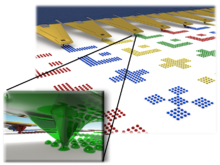Electronic nano-lithography and the fields of biology and medicine (less than 10 nm) (PhD in nano-microelectronics)
Researcher and author: Dr. ( Afshin Rashid)
Note: There is a growing interest in nano-lithography for interdisciplinary applications, mainly in the fields of biology and medicine.
Nano-lithography enters the game from two directions. First, it can be used to build electronic devices that provide digital readings of a particular measurement or allow a specific external action to be performed. Second, given the micrometer or nanometer size of objects such as bacteria, viruses, proteins, DNA, etc., artificial objects of similar size are suitable for interacting with those organisms.
You develop electronic devices on flexible use of nano-lithography in new applications and new biomedical (biopsy, planting for excitation light, a piece of heart, brain mapping), LED flexible, touch screen and flexible pressure sensors And the temperature has expanded. For the future, but a fast approaching reality, flexible electronics for communication between man and machine, such as an artificial retina is developing .cha Lash new chemical warfare, pollution, disease diagnosis and detection of drugs Development under the umbrella is the concept of the electronic nose, where a small device must be able to detect the desired material and react quickly. Nanostructure is very important for downsizing the device, making electronic components and integrating them. Electronic nose should ideally perform sensor, signal processing and signal transmission. With the increasing importance of robots in our daily lives, nanolithography plays a key role in making sensors and actuators smaller and faster, as well as electronic devices suitable for advanced control and communication of components. The robot will play. Changing the paradigm from classical computing to quantum computing to do some computing creates new challenges for building qubits as well as optimal electronic equipment. The scenario is still quite open, but in most of the proposed methods lithography is one of the key activating technologies . Other alternative computational designs, such as neuromorphic calculations, also rely on nano-lithography.
Conclusion:
Depending on the micrometer or nanometer size of objects such as bacteria, viruses, proteins, DNA, etc., artificial objects of similar size are suitable for interacting with those organisms.




